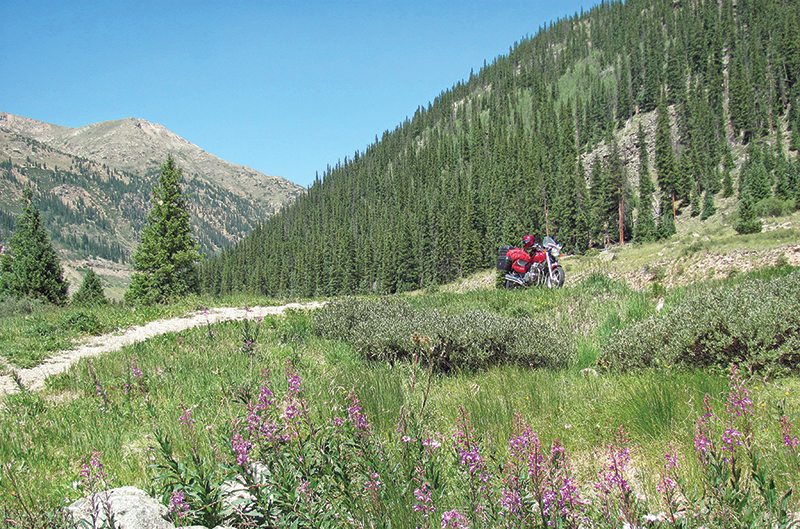
As children, we heard many of Grandma Louise’s stories about Colorado. She was born in a log cabin a few miles outside of Creede, to a mother who had been born in Leadville and spent part of her childhood in Cripple Creek. This family history at high altitudes caught my imagination when, a couple years ago, I started looking for these places on a map. I couldn’t help but notice the winding two-lane roads and high passes on a route that traversed through those towns. Out rolled my motorcycle on a sunny day in August, and off I rode to search for my roots in the mountains of Colorado.
My first destination involved popping over Wolf Creek Pass from Durango. Once on the east side of the Continental Divide, I turned north along the headwaters of the Rio Grande. The valley I followed was wild, isolated and beautiful. I tried to imagine what it might have felt like to be a child living so far from civilization. Several miles past Wagon Wheel Gap, I turned onto a scarcely marked dirt road that led to La Garita Ranch.
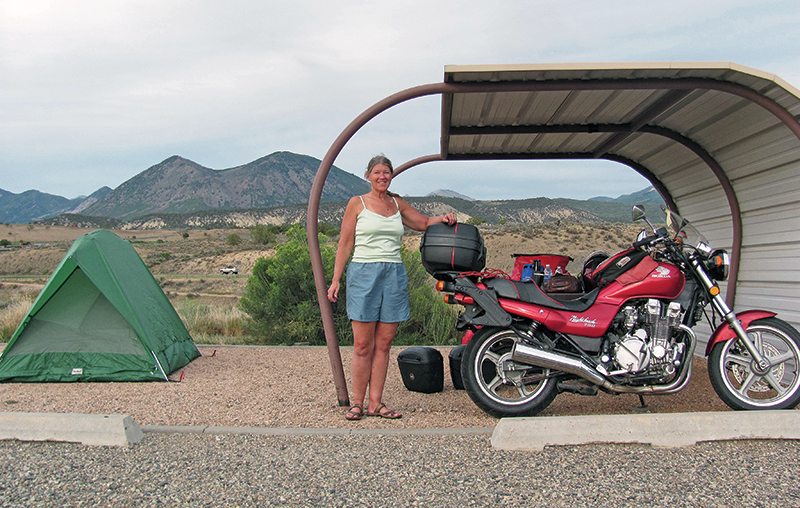
Senator Lawrence Phipps purchased the ranch in 1908 as a fishing and hunting retreat for himself and his buddies. My great-grandfather, Otto Crain, worked as the first ranch foreman. He arrived with his new bride, Gertrude Kavanagh, right after their New Years Day wedding in 1909. In a one-room log cabin that October, Gertrude gave birth to their first child, Louise.
Phipps La Garita Ranch is still a retreat for the rich and famous. The private guest ranch offers horseback riding, fishing in the Rio Grande and relaxing in a lodge with picture windows framing the adjacent La Garita Wilderness. A few weeks before I visited, Johnny Depp and company stayed there while filming portions of The Lone Ranger.

Continuing my ride upstream along the Rio Grande River and the old railroad bed for a few miles, I reached Creede, a mining town that boomed in the 1890s. This would have been the closest town for the young Crain family to buy supplies, get medical help or meet their neighbors. It took me 15 minutes to ride there, but might have taken them half a day.
A Polish hot dog purchased at the Best Little Dog House in Creede satisfied my hunger while only setting me back $3.75. Heading north out of town, State Route 149 carried me past the Rio Grande Reservoir and over two high passes. A flash of blue caught my eye at the top of Slumgullion Pass as a Mountain Bluebird flapped past, thriving like the evergreen trees at 11,000 feet.
The Silver Thread, as this highway is known, looped down to Lake City, another isolated mountain town founded in the latter part of the 19th century to serve as the commercial center for nearby mining claims. Today it hangs on mostly due to a small but steady procession of two- and four-wheeled explorers traveling the rough dirt roads of the Alpine Loop Backcountry Byway from Silverton.
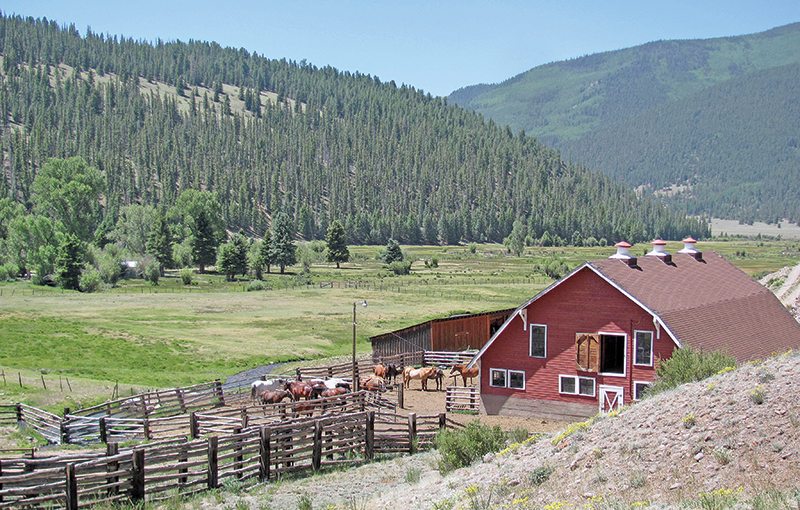
I crossed Highway 50, rode beside Blue Mesa Reservoir for a while, and found a place to camp at Crawford State Park. The next morning I rode to Paonia, longtime site of a well-known BMW rally. Paonia was a scattering of valley bottom farms watered by the Gunnison River, with roads running out like spokes to a number of spectacular high country loops. The perfect base camp for a motorcycle rally! I followed Highway 133 over the pass to Redstone.
Emerging from the mountains, I stopped for a breakfast burrito in Carbondale. The red rocks made a nice backdrop for a down-to-earth sort of town. Turning uphill out of Carbondale, I spied a newly ignited brush fire running up a hill on some public land run by the Bureau of Land Management.
My pulse quickened reflexively, since I have worked for more than 20 years in the fire suppression field. But a helicopter had already been launched and it was working the flames with its bucket. A few miles later, I reached world-famous Aspen. To my right, trees were clear-cut in rows down the mountainsides to accommodate ski lifts and world-class runs. Nothing of interest to a motorcyclist in August!
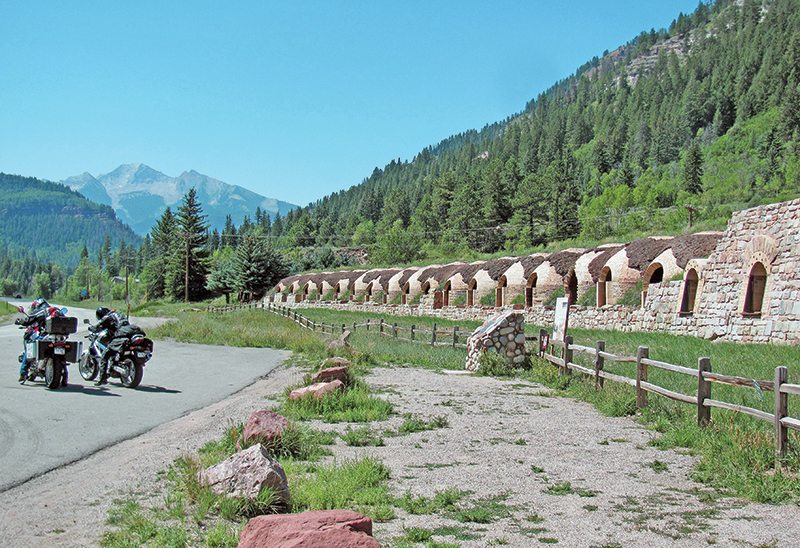
The paved approach to Independence Pass narrowed, with curves turning back on themselves. I leaned into the arcs and breathed deeply of the thin air at 12,150 feet of elevation. On both sides, numerous Fourteeners–otherwise known as really big mountains–towered over the pass.
When I finally reached Leadville late in the day, I was dismayed to find that a “Boom Days” festival was underway, and every hotel was full. A hotel clerk took pity on a weary motorcyclist who had just ridden 500 miles across the rooftop of Colorado. She made some calls and found me the last available room in town.
Refreshed and revitalized after changing into shorts and sandals, I walked downtown to look at the restored grandeur of Leadville. The town had been the second largest in Colorado during the mining heyday of the 1880s, with a population estimated at 40,000 people. Here passed through famous folks like Horace Tabor, Doc Holliday, Harvey Mudd and Poker Alice. Here too settled thousands of not-so-famous miners and people servicing them, including my great-great-grandfather, Civil War veteran Austin Kavanagh. He, along with his wife Mary and several children, made the difficult trek across the country by rail, stage and foot to reach Leadville in 1882. Austin had some connections with politicians and businessmen from his native Boston, so he established himself as the right-hand-man of a wealthy local businessman in Leadville. Most of their children perished in the harsh conditions at 10,400 feet elevation, but then two more (including my great-grandmother Gertrude) were born in Leadville, growing up fit and hardy in the rough mountain town.
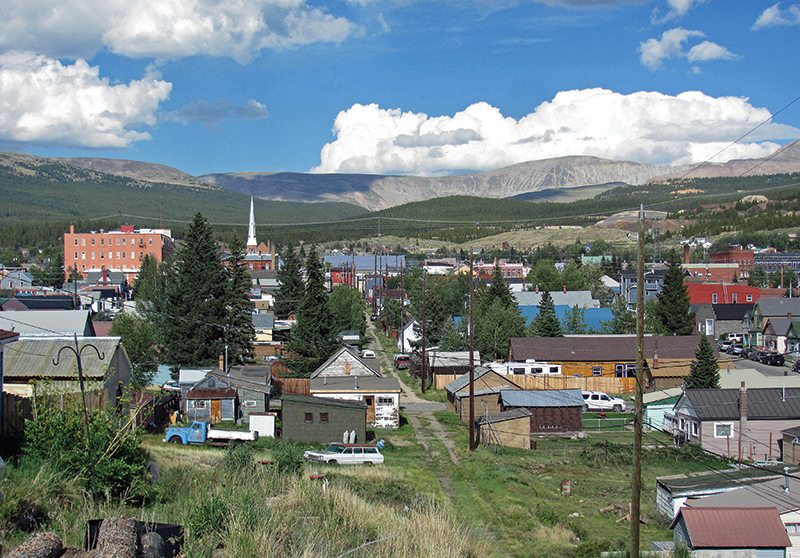
I tried to imagine, as I admired the ornate architecture of the Delaware Hotel and the collected antiques in the Healy House, what it might have been like to grow up in a lawless mining town where, so the saying goes, summer only lasts for 30 days, and those days are never consecutive. I felt great (if a little winded) walking around two miles above sea level on one of those 30 summer days, enjoying fake shootouts in the street and women parading in period costumes for Boom Days. Typical street food, gyros and lemonade, tasted extra-flavorful in the thin air at the top of the world.
The next day, I rode out of Leadville and down a side road to reach the Leadville National Fish Hatchery. As I walked the nature trail between the lakes above the hatchery, I pictured my grandmother Louise and her seven siblings wandering around in these woods while their dad raised trout. The Crain family moved here after several years in Creede and lived in a tiny cabin behind the main hatchery building. The hatchery was a peaceful, natural place where I imagined the children would grow up away from the influence of crooked miners and other shady characters back in town. They lived there in apparent bliss, a loving Irish-American family with a new baby arriving almost every year.

As I rode down the mountain from Leadville and headed east to Cripple Creek, I thought about Gertrude’s hardy upbringing. For several years during Gertrude’s childhood, the Kavanaghs lived in this rough mining town, the scene of grim mining accidents, workers’ riots and shootouts in the 1890s. What violence did she witness as a child there, and how did she stay out of harm’s way? The formerly difficult trip across wild mountain terrain between Buena Vista and Florissant was smoothed by some gently curving asphalt roads. A spur road to Cripple Creek rose steeply out of cattle and llama ranch lands into jagged black rock cliffs.
Cripple Creek has long since ceased to be a mining town, unless you count mining for people’s hard-earned savings. The main street was lined with casinos, attracting people from Denver and Colorado Springs to try their luck on the poker machines and roulette wheels.
An unexpected surprise and delight on the downhill side of town was a sweet little two-lane backcountry road, adorned with luscious undulations and sweeping curves. Lined with late summer sunflowers and scented of juniper, the road was posted with 25-mph speed-limit signs but I confess to doing twice that, leaning into the rounds and sharing the road with only a handful of Sunday ramblers, mostly motorcyclists.
In high summer, with mild temperatures and flowers abloom, it was tempting to stay longer in the Colorado Rockies. I’m sure Gertrude’s family felt that way too, until the fateful year in which their fortune changed. In the fall of 1919, a horse stepped on Otto Crain while he was working at the hatchery. Over the next couple weeks, the injury became infected. Lacking antibiotics, the doctor wasn’t able to halt it. Septic shock set in, and Otto died in November, leaving Gertrude a widow with seven children to support. She managed to survive by farming out the kids and finding work as a waitress in a Harvey House. Five years later, Gertrude gathered her family and bailed out of the mountains, riding a train to Pasadena, California, to live with her sister.
The Crains were unable to stay in Colorado. But the mountains stayed with them. More than 60 years later, Grandma Louise reminisced fondly about blooming columbine and fireweed, tall spruce trees, ice-cold clear lakes and aspen leaves shimmering like fire in the weak autumn sun. I saw Colorado as she described it, big and bright and beautiful. Long after my ride ended, the power of the mountains still reverberated. Someday soon, I will return to learn more about the pioneering spirit of my ancestors who carved a life for themselves in the wild highlands of the Colorado Rockies.
(This article Colorado Roots in the Rockies was published in the August 2014 issue of Rider magazine.)

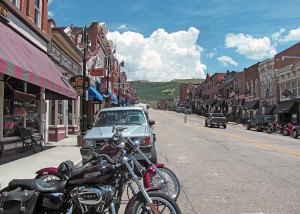
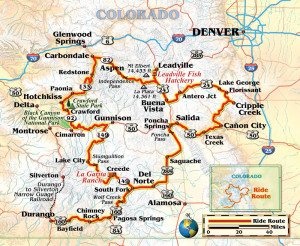
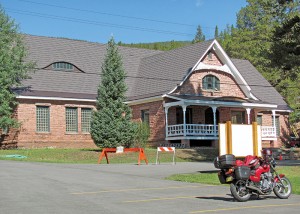







What is the rack system for your saddlebags on your Honda? Hondaline or aftermarket?